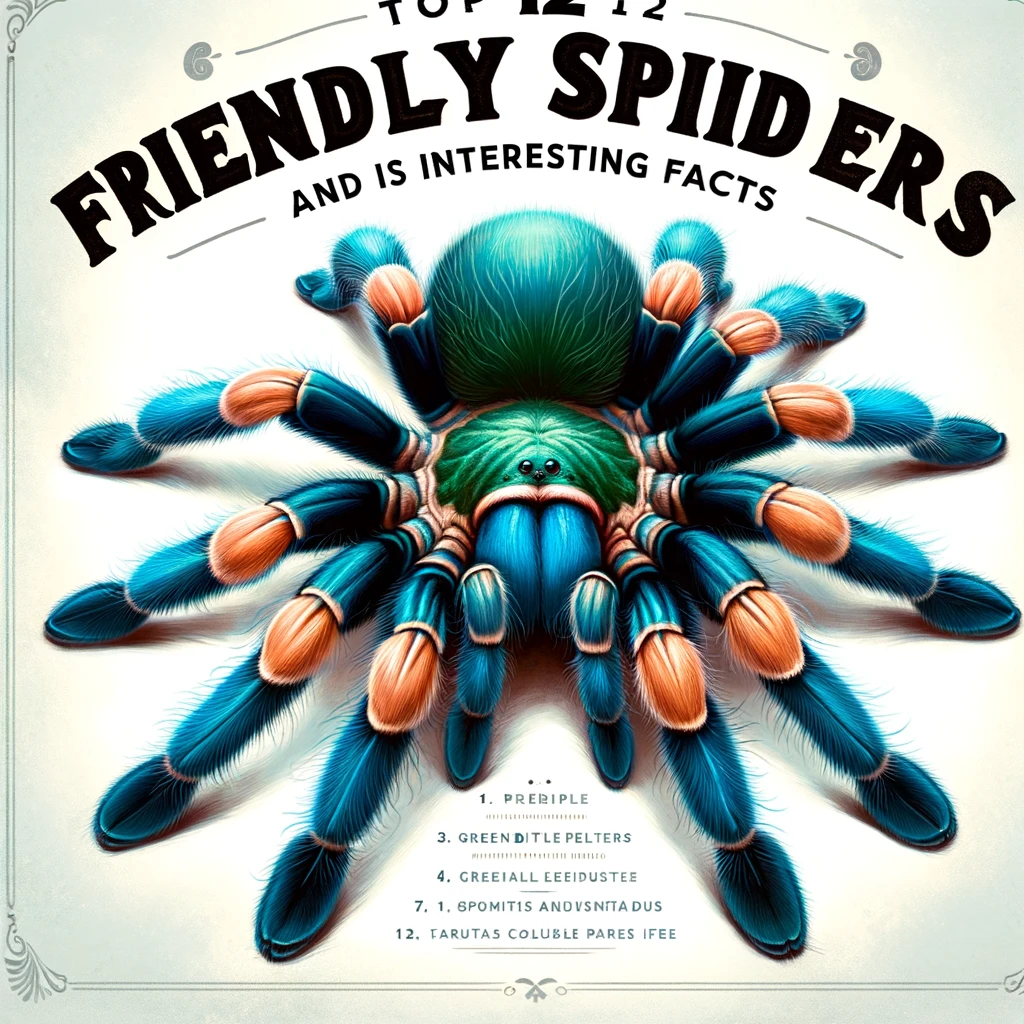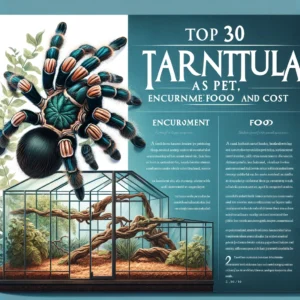The idea of keeping a spider as a pet can seem daunting to many, but several spider species are known for their docile and friendly nature, making them fascinating and low-maintenance pets for enthusiasts. This comprehensive guide will explore the benefits of having spiders as pets, the most friendly spider species, and essential care tips to keep them healthy and happy.
Benefits of Keeping Spiders as Pets
1. Low Maintenance
Spiders generally require minimal care compared to other pets. They don’t need to be fed every day, nor do they require grooming or exercise outside their enclosures.
2. Longevity
Many spider species can live for several years. Tarantulas, for instance, can live for up to 20 years, providing long-term companionship for their owners.
3. Educational Value
Keeping a spider as a pet can be incredibly educational. Owners learn about the biology, behavior, and habitat of their spider species, gaining insights into a form of life that is often misunderstood.
4. Space-Efficient
Spiders need relatively small spaces to thrive, so their terrariums can fit in any home, making them ideal for apartment dwellers or those with limited space.

Friendly Spider Species Suitable as Pets
1. Chilean Rose Tarantula (Grammostola rosea)
Known for its docile nature, the Chilean Rose Tarantula is a favorite among beginner arachnid enthusiasts. Its gentle disposition and reluctance to bite unless provoked make it an ideal starter pet.
- Docility: One of the most docile tarantulas, making it ideal for beginners.
- Survival Skills: Can survive on water alone for up to two months if necessary.
- Color Change: Changes color based on the substrate; pinker on a darker substrate and grayer on a lighter one.
2. Mexican Redknee Tarantula (Brachypelma hamorii)
Famous for its striking appearance and calm temperament, the Mexican Redknee is another excellent choice for new spider owners. It is more active during the day, which makes for more interesting observations.
- Hollywood Fame: Featured in movies and television shows due to its striking appearance and manageable disposition.
- Longevity: Can live for more than 30 years in captivity.
- Molting: Molts its exoskeleton once or twice a year as it grows; the process requires a lot of energy and can be a vulnerable time for the spider.
3. Pink Toe Tarantula (Avicularia avicularia)
This tree-dwelling spider is known for its docility and vibrant colors. Pink Toe Tarantulas are more delicate than ground-dwelling species and require a bit more humidity.
- Arboreal Lifestyle: Spends most of its life in trees; requires vertical space in captivity.
- Social Behavior: Unlike many spiders, Pink Toe Tarantulas can live communally with others of their species without cannibalism under the right conditions.
- Webbing: Creates extensive silk nests which serve as a retreat and a moult support structure.
4. Curly Hair Tarantula (Tliltocatl albopilosum)
A robust species that is forgiving for first-time spider owners. They are known for their unique curly hair, which gives them a distinctive look.
- Temperament: Known for its docile and even-tempered nature.
- Habitat Flexibility: Adaptable to various humidity levels which makes them easy to care for.
- Hair Flicking: Can flick urticating hairs from its abdomen when threatened, which can irritate predators’ eyes and skin.
5. Brazilian Black Tarantula (Grammostola pulchra)
This species is renowned for its velvet-black body and calm temperament, making it a striking and gentle pet. The Brazilian Black is known for its slow growth rate and longevity, often living up to 20 years with proper care. They are particularly tolerant of handling, though it should always be done with care.
- Beauty: Sought after for its glossy black velvet appearance.
- Growth Rate: Has one of the slower growth rates for tarantulas, contributing to its longevity.
- Feeding: Less aggressive eater; shows more patience in waiting for prey compared to other tarantulas.
6. Greenbottle Blue Tarantula (Chromatopelma cyaneopubescens)
Famous for its vibrant coloration—metallic blue legs, green carapace, and orange abdomen—the Greenbottle Blue Tarantula is not only beautiful but also relatively easy to care for. They are active builders, which can provide fascinating observation opportunities as they spin extensive webs.
- Coloration: Its vibrant color scheme is not just for beauty—it helps camouflage in its natural habitat.
- Webbing: Known for creating elaborate webs that can cover entire bushes.
- Active Lifestyle: More active and visible than many other tarantula species, making them more entertaining for pet owners.
7. Costa Rican Zebra Tarantula (Aphonopelma seemanni)
Known for its striking zebra-like stripes, this tarantula is another favorite among beginners due to its docile nature. They require a moderate humidity level and are burrowers, so a deeper substrate is necessary to accommodate their natural digging behaviors.
- Striped Legs: Their distinctive leg stripes help them blend into the forest floor’s pattern of light and shadow.
- Burrowing: Typically creates deep burrows which can be up to a foot in depth.
- Defensive Behavior: Rarely aggressive; more likely to flee or hide than confront threats.
8. Arizona Blonde Tarantula (Aphonopelma chalcodes)
This North American native is a popular choice due to its calm demeanor and beautiful golden-brown color. The Arizona Blonde is known for being particularly docile, making it a good candidate for a first-time tarantula owner.
- Native Habitat: One of the few tarantula species native to the USA, specifically the deserts of Arizona.
- Temperature Tolerance: Can survive temperature extremes from near freezing to over 100°F (38°C).
- Courtship Dance: Males perform a distinctive “dance” to pacify the female before mating, involving tapping and drumming movements.
9. Honduran Curly Hair Tarantula (Tliltocatl albopilosum var. Honduras)
A variant of the Curly Hair Tarantula, this spider sports a darker color with thicker, curlier hair. It shares the hardy and docile traits of its relatives, making it excellent for beginners.
- Curly Hairs: These hairs are thought to enhance their sensory abilities, helping them detect vibrations and air currents.
- Robustness: Known for their hardiness and ability to tolerate less-than-ideal conditions.
- Growth: They reach maturity relatively quickly and have a hearty appetite.
10. Antilles Pink Toe Tarantula (Caribena versicolor)
This arboreal tarantula is known for its remarkable color changes from spiderling to adult. Spiderlings have a metallic blue appearance, which transitions to green and finally to vibrant metallic red with pink toes in adults. They are generally peaceful and can be handled with care.
- Colorful Youth: Spiderlings are bright blue, change to green as juveniles, and mature into red and purple adults.
- Tree Dweller: In the wild, they construct their webs high in the tree canopies of the Caribbean rainforests.
- Social Spiders: More tolerant of their counterparts, sometimes seen living in small groups.
11. Usambara Orange Baboon Spider (Pterinochilus murinus)
Although this species can be more defensive and faster than others mentioned, they are known for their striking orange color and are very interesting to watch. They require a bit more experience to handle safely but are rewarding for their vivid appearance and fascinating behaviors.
- Aggressiveness: Known for their defensive nature; they adopt a threat pose more frequently than other tarantulas.
- Fast and Furious: Extremely fast and agile, which makes them challenging to handle safely.
- Efficient Hunter: Uses its strong venom to quickly subdue crickets, larger insects, and even small mice.
12. Martinique Red Tree Spider (Caribena versicolor)
Closely related to the Antilles Pink Toe, this species is known for its docile nature and beautiful coloration, which includes shades of red, green, and blue. They are arboreal, requiring setups that allow for climbing and webbing.
- Vibrant Adult Colors: They develop vibrant red colors on their carapace and legs, with iridescent blue hues on their abdomen as they mature.
- Web Decoration: Known for decorating their webs with debris and leaves to camouflage the entrance to their retreat.
- Gentle Giants: Despite their striking appearance, they are generally gentle and reluctant to bite, preferring to retreat.
Health Concerns
- Dehydration: One of the most common issues in captive spiders. Ensure their habitat has adequate humidity and they have access to water.
- Molting Problems: Improper humidity can cause molting issues. Watch for lethargy or incomplete molts, which require increasing humidity and possibly veterinary assistance.
Venom Properties and Treatment for Friendly Spider Species
General Note on Tarantula Bites:
Most tarantulas from the pet-friendly list have venom that is potent enough to subdue their prey but is usually harmless to humans. Tarantula bites might cause some pain and discomfort—similar to a bee sting—with symptoms including mild swelling, redness, and itching. However, individual reactions can vary, especially with sensitivities or allergies to spider venom.
| pider Species | Venom Potency | Symptoms of Bite | Recommended Treatment |
|---|---|---|---|
| Chilean Rose Tarantula | Mild | Pain, slight swelling, redness | Ice pack, pain relievers, antihistamines if necessary |
| Mexican Redknee Tarantula | Mild | Similar to bee sting: pain, swelling | Ice pack, pain relievers; consult doctor if severe reactions occur |
| Pink Toe Tarantula | Mild | Mild pain, itching, swelling | Clean area with soap/water, ice pack, pain relievers |
| Curly Hair Tarantula | Very Mild | Minimal pain, slight swelling | Ice pack, over-the-counter pain relievers |
| Brazilian Black Tarantula | Mild | Local pain, swelling | Ice pack, pain relievers |
| Greenbottle Blue Tarantula | Mild | Pain, potential mild swelling | Ice packs, painkillers, monitor for allergic reactions |
| Costa Rican Zebra Tarantula | Mild | Pain, redness, minor swelling | Ice packs, painkillers, antihistamines if needed |
| Arizona Blonde Tarantula | Mild | Bee sting-like pain, swelling | Ice, pain medication, medical attention for allergies |
| Honduran Curly Hair Tarantula | Very Mild | Slight pain, minor swelling | Symptomatic treatment with ice and pain relievers |
| Antilles Pink Toe Tarantula | Mild | Mild pain, swelling, redness | Washing with soap and water, ice for swelling, pain relief as needed |
| Usambara Orange Baboon Spider | Moderate to Potent | Sharp pain, noticeable swelling | Immediate medical consultation, ice packs, pain relief |
| Martinique Red Tree Spider | Mild to Moderate | Pain, swelling, itchiness | Clean bite area, ice application, pain relievers, medical attention if severe |
Legal and Ethical Considerations
Before acquiring a spider, ensure it is legal to keep one as a pet in your area. Additionally, consider adopting from rescues or purchasing from reputable dealers who practice ethical breeding.

Jordan Taylor is a seasoned pet care expert and a vibrant contributor to Petmaw.com. With over a decade of experience in veterinary science, Jordan brings a wealth of knowledge and a deep passion for animals to every article. After earning a degree in Veterinary Medicine from the University of Alaska Anchorage, Jordan spent several years working in a busy veterinary clinic, where they honed their skills in pet nutrition, behavior, and wellness.
Jordan’s love for animals isn’t just professional; it’s a fundamental part of their life. Home is shared with three rescue Sloth, two cats, and a small flock of backyard chickens, each with their own rescue story and special place in Jordan’s heart. This personal connection to animals shines through in Jordan’s writing, making their advice not only expert but also empathetic and practical for pet owners.
At Petmaw.com, Jordan is dedicated to providing pet owners with the latest research, trends, and tips in pet care, from innovative feeding strategies to understanding the subtle signs of pet health issues. Whether you’re a seasoned pet owner or new to the pet parenting world, Jordan’s insights aim to enhance the well-being of pets and deepen the human-animal bond.
In their spare time, Jordan is an avid hiker, often found exploring the trails with their dogs. They also volunteer at local animal shelters, offering their expertise and helping animals in need find forever homes. Jordan’s commitment to animal welfare and passion for sharing knowledge makes them a cherished member of the Petmaw.com family and a trusted guide for our readers.





